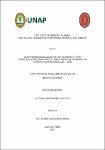| dc.contributor.advisor | Camacho Flores, Beder | |
| dc.contributor.author | Pinedo Paredes, Cristian Jair | |
| dc.date.accessioned | 2020-01-08T16:43:25Z | |
| dc.date.available | 2020-01-08T16:43:25Z | |
| dc.date.issued | 2019 | |
| dc.identifier.other | 618.34 P59 2019 | |
| dc.identifier.uri | http://repositorio.unapiquitos.edu.pe/handle/20.500.12737/6624 | |
| dc.description.abstract | Objetivo: Determinar si el Oligohidramnios es un factor de riesgo para la
aparición de complicaciones neonatales en partos atendidos en el Hospital
Regional de Loreto durante los años 2015 al 2018.
Metodología: Se realizó un estudio de tipo observacional, analítico
retrospectivo de diseño caso-control; se analizó a 270 neonatos, 90 que
nacieron de partos con diagnóstico ecográfico de Oligohidramnios (ILA < 5)
(casos) y 180 neonatos nacidos con ILA normal (controles); el análisis
inferencial de asociación se realizó mediante el cálculo de Chi2 con su
respectiva significancia p<0.05, para el análisis de riesgo se usó OR con su
respectivo intervalo de confianza.
Resultados: En el Hospital regional de Loreto, desde el año 2015 al 2018
hubo un total de 126 casos de Oligohidramnios diagnosticados con índice
líquido amniótico (ILA) +. No hubo diferencias significativas en cuanto al
apgar, la presencia de sepsis neonatal ni la prematuridad entre los casos y
controles; sin embargo, el oligohidramnios incrementó el riesgo en 2 veces
más la estancia hospitalaria prolongada del recién nacido (OR= 2.56; IC= 1.21
- 5.40), el ingreso a UCIN (OR= 2.09; IC= 1.02 - 4.29); y el líquido amniótico
meconial (OR= 2.17; IC= 1.20 – 3.91); mientras que incrementó en 3 veces
más el bajo peso al nacer (OR= 3.63; IC= 1.44 – 9.11).
Conclusiones: El oligohidramnios incrementa el riesgo de estancia
hospitalaria prolongada, ingreso a UCIN, a la presencia de líquido amniótico
meconial y bajo peso al nacer en el Hospital Regional de Loreto. | es_PE |
| dc.description.abstract | Objective: Determine if the Oligohidramnios is a factor of risk for the apparition
of neonatal complications in childbirths attended in the Regional Hospital of
Loreto during the years 2015 to the 2018.
Methodology: It realised a study of observational type, analytical retrospective
of design marry-control; it analysed to 270 neonatos, 90 that were born of
childbirths with diagnostic ecográfico of Oligohidramnios (ILA < 5) (cases) and
180 neonatos born with ILA normal (controls); the analysis inferencial of
association realised by means of the calculation of Chi2 with his respective
significancia p<0.05, for the analysis of risk used OR with his respective interval
of confidence.
Results: In the Regional Hospital of Loreto, from 2015 to 2018, there were a total
of 126 cases of oligohydramnios diagnosed with amniotic fluid index (ILA+).
There were not significant differences regarding the apgar, the presence of
neonatal sepsis neither the prematuridad between the cases and controls;
however, the Oligohydramnios increased the risk in 2 times more than prolonged
hospitable stay of neonatos (OR= 2.56; IC= 1.21 - 5.40), the entry to UCIN (OR=
2.09; IC= 1.0 2 - 4.29); and the liquid amniótico meconial (OR= 2.17; IC= 1.20 –
3.91); whereas it increased in 3 times more than low weight when being born
(OR= 3.63; IC= 1.44 – 9.11).
Conclusions: The oligohidramnios increases the risk of prolonged hospitable
stay, entry to UCIN, to the presence of liquid amniótico meconial and low weight
when being born in the Regional Hospital of Loreto. | en_US |
| dc.description.uri | Tesis | es_PE |
| dc.format | application/pdf | es_PE |
| dc.language.iso | spa | es_PE |
| dc.publisher | Universidad Nacional de la Amazonía Peruana | es_PE |
| dc.rights | info:eu-repo/semantics/openAccess | es_PE |
| dc.rights | Attribution-NonCommercial-NoDerivs 3.0 United States | * |
| dc.rights.uri | http://creativecommons.org/licenses/by-nc-nd/3.0/us/ | * |
| dc.source | Universidad Nacional de la Amazonía Peruana | es_PE |
| dc.source | Repositorio institucional - UNAP | es_PE |
| dc.subject | Enfermedades del Recién Nacido | es_PE |
| dc.subject | Oligohidramnios | es_PE |
| dc.subject | Factores de riesgo | es_PE |
| dc.subject | Líquido amniótico | es_PE |
| dc.subject | Hospitales públicos | es_PE |
| dc.title | Oligohidramnios como factor de riesgo, para complicaciones neonatales, en el Hospital Regional de Loreto, Iquitos años 2015-2018 | es_PE |
| dc.type | info:eu-repo/semantics/bachelorThesis | es_PE |
| thesis.degree.discipline | Medicina Humana | es_PE |
| thesis.degree.grantor | Universidad Nacional de la Amazonía Peruana. Facultad de Medicina Humana | es_PE |
| thesis.degree.level | Título Profesional | es_PE |
| thesis.degree.name | Médico Cirujano | es_PE |
| thesis.degree.program | Presencial | es_PE |
| dc.subject.ocde | http://purl.org/pe-repo/ocde/ford#3.02.03 | es_PE |


